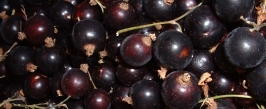Blackcurrant
|
|
| Blackcurrant | ||||||||||||||
|---|---|---|---|---|---|---|---|---|---|---|---|---|---|---|
 | ||||||||||||||
| Scientific classification | ||||||||||||||
|
The blackcurrant is a temperate shrub which produces small edible berries with a high natural vitamin C content, which are very dark purple/blue in colour—almost black—hence the name. Like the other true currants (not to be confused with the Zante currant, a type of grape which is often dried), it is classified in the genus Ribes.
Blackcurrants have a slightly bitter taste; They are made into jam, ice cream, cordial and liqueur. In the UK, Europe and Commonwealth countries, some types of confectionery include a blackcurrant flavour, but this is generally missing in North America, even in the same brand.
In North America, grape flavour in candy (including grape jelly Brit. jam) almost mirrors the use of blackcurrant in both its ubiquity there, and its rarity on the opposing side of the Atlantic.
In bars, the blackcurrant cordial is referred to simply as "black", as in "vodka and black", "snakebite and black", "Pernod and black", or "black and lemonade". In North America, blackcurrant cordial is more commonly known as crème de cassis whilst in Britain and France crème de cassis is an alcoholic blackcurrant liqueur, used for making the popular apéritif Kir; the city of Dijon in France particularly known for this liqueur. In the Netherlands, cassis is a popular, red-coloured, soft drink with a blackcurrant flavour.
When not in fruit, the aspect of the plant is very similar to the redcurrant, however there is a way to distinguish them. The leaves and stems of the blackcurrant have a strong odour reminiscent of cat's urine.
In Britain, Australia and New Zealand a blackcurrant cordial under the brand name of Ribena (from the genus name) is principally marketed as a 'healthy' (if extremely sweet) drink for children.
Blackcurrant seed oil is a rich source of gamma-linolenic acid (GLA), a very rare essential fatty acid.
Blackcurrants are rare in the United States owing to the fact that in the early 1900's, currant farming was banned due to its ability to spread disease among white pines which threatened the then-booming lumber industry. Currant growing is now making a comeback in the United States, however the fruit is not well-known and so has not reached the popularity that it has seen in Europe.bg:Касис cs:Černý rybíz da:Solbær (Ribes nigrum) de:Johannisbeere eo:Ribo fi:Mustaherukka nl:Zwarte bes zh:黑加仑
